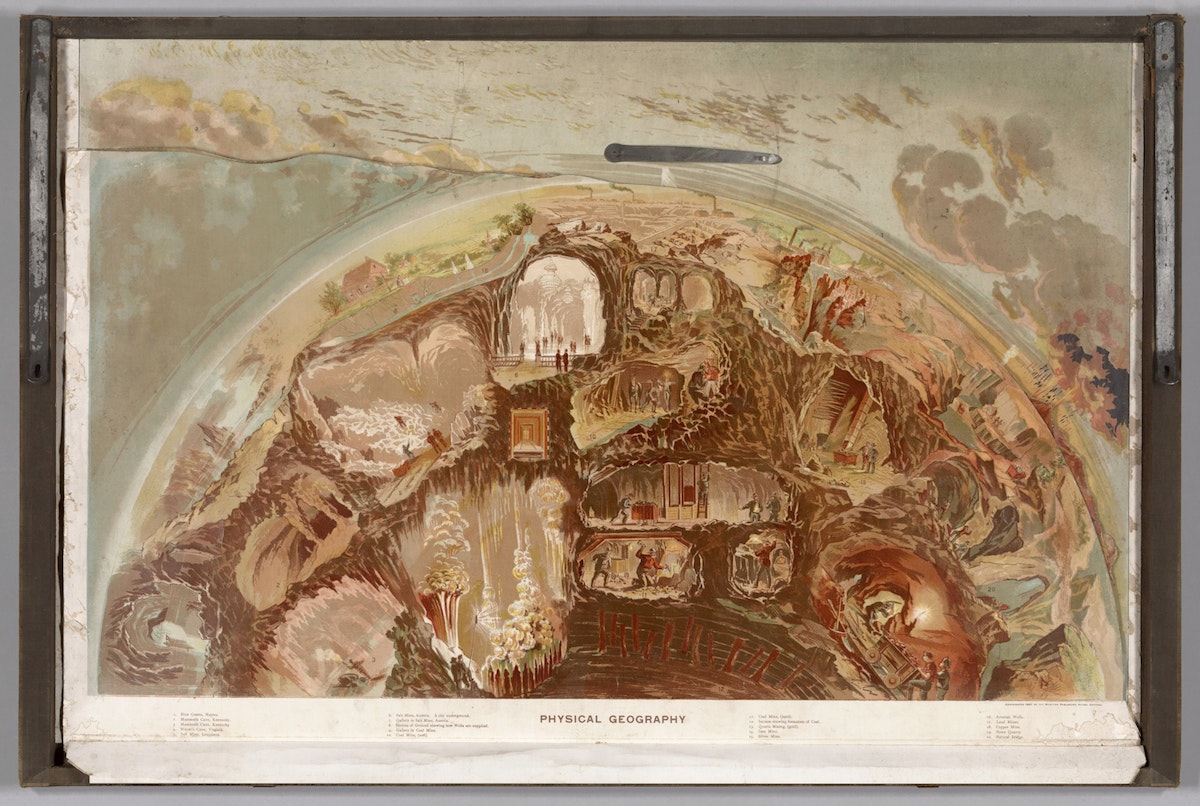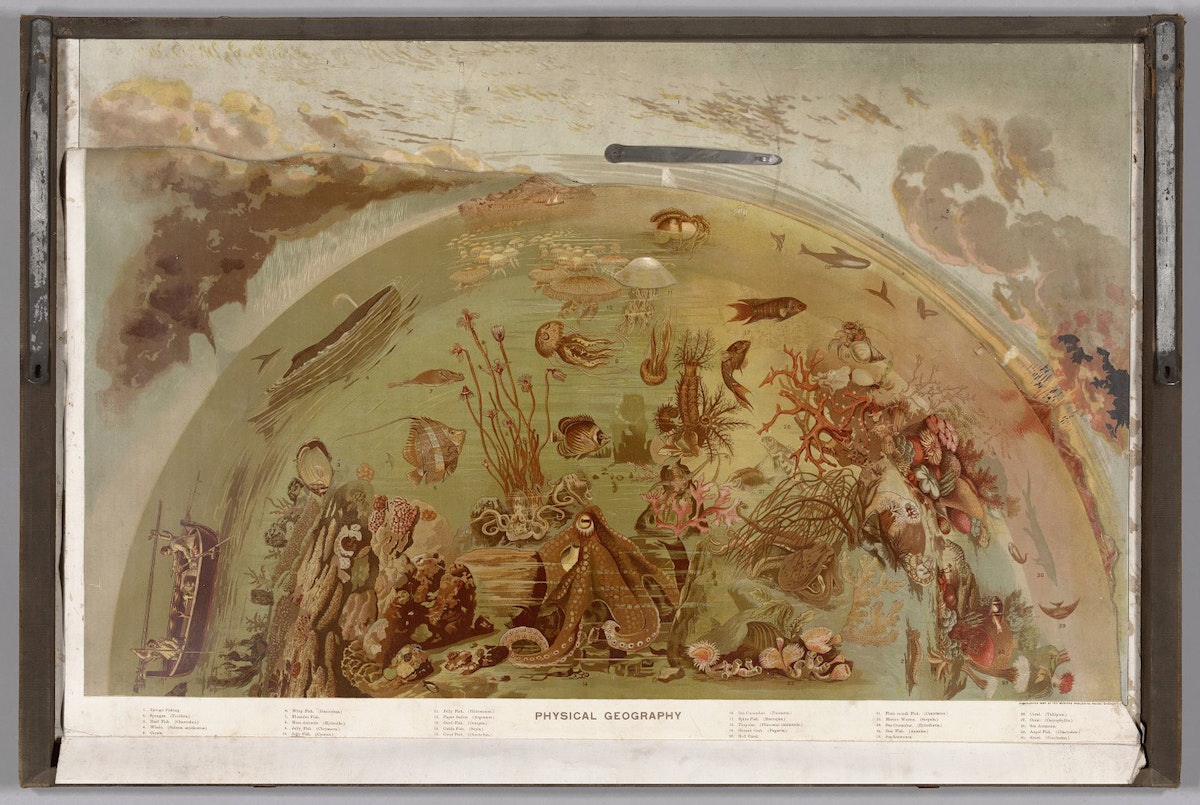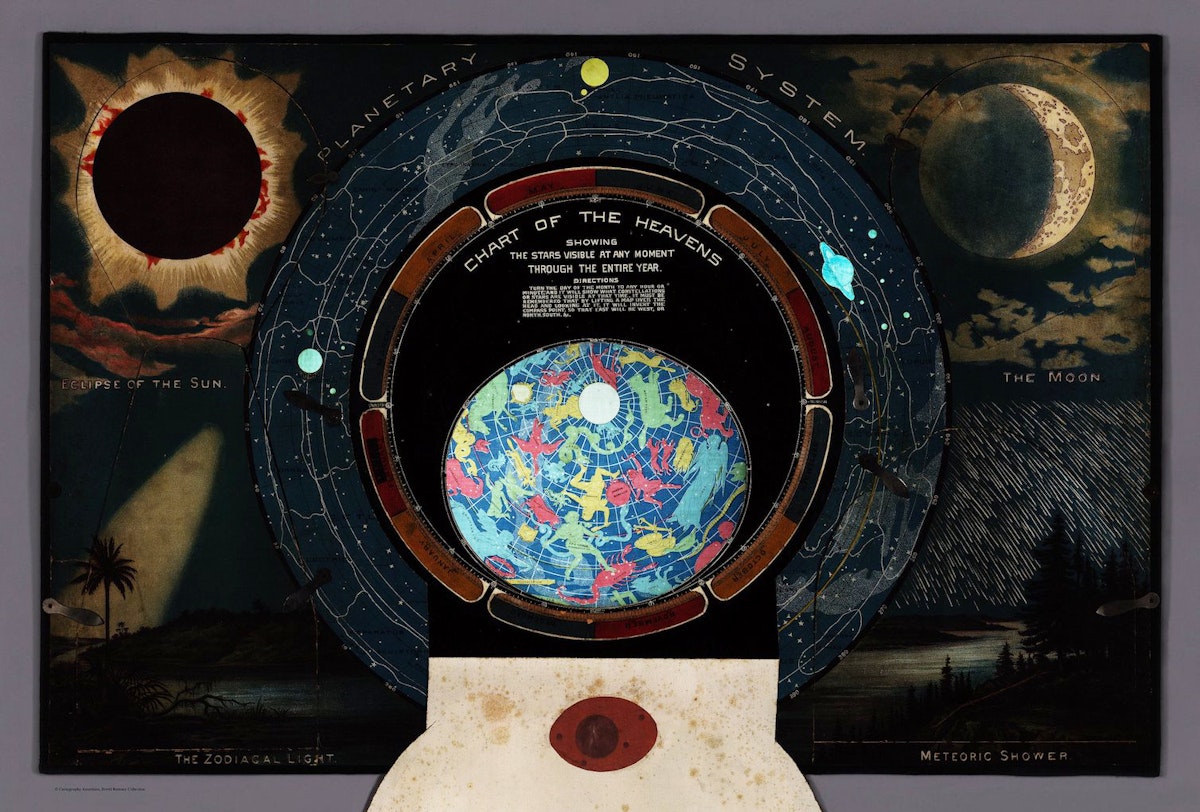Levi Walter Yaggy’s Geographical Maps and Charts (1887/93) (original) (raw)
Levi Walter Yaggy’s Geographical Study (1887) unpacks like a matryoshka doll. The experience begins with a heavy wood box, outfitted with leather straps and brass clasps, inside of which is a sheaf of complex maps and charts, and a learning guide on how they should be used in the classroom. The maps are each the size of a small rug (ranging between two and four feet) — large enough to lay on the floor and have pupils gather around — and all save one are printed expensively, on thick paper with chromolithography. The exception is a green relief map of the United States, made of plaster and papier-mâché and built directly in the carrying case. It’s the least charming of the suite, though it made Yaggy justifiably proud: most of the mountains he depicts had yet to be measured. The remaining maps, of Earth and its cosmos, are packed in such a way as to avoid being crinkled by the Rocky Mountains.
Some of “Yaggy’s maps”, as they were usually called, are straightforward two-dimensional posters, but others feature elaborate cutaways and intricate layers. “Physical Geography”, for instance, presents as a bucolic orb of rivers and fields, with an erupting volcano in the corner. By adjusting riveted metal tabs, this scene falls away, and a new view is revealed underneath, showing all variety of subterranean human activity: Venetian grottoes; a cave in Kentucky; quartz, salt, and coal mines. Beneath this layer is another, with a diagram of the stratified ages of the earth in striped autumnal colors; and then, finally, the mass of land becomes a bustling aquarium, starring a one-eyed octopus and a fleet of pulsing jellyfish. The cutaways in Yaggy’s “Planetary System” map are even more complex. Seasons can be adjusted with a dial, and translucent linen inlays reveal the corresponding placement of constellations, which shine when backlit. There’s a cutaway showing the phases of a solar eclipse, and another with a view of the moon as seen by the world’s most powerful telescope. Every corner packs a surprise; the innermost layer, “Chart of the Heavens”, draws the nocturnal sky like a party, crowded with animals and gods. ※
 Scroll through the whole page to download all images before printing.
Scroll through the whole page to download all images before printing.
Physical Geography, with the map’s subterranean layer displayed, from Yaggy’s Geographical Study, 1887
 Scroll through the whole page to download all images before printing.
Scroll through the whole page to download all images before printing.
Physical Geography, with the map’s submarine layer displayed, from Yaggy’s Geographical Study, 1887
Mapmaker was not Levi Walter Yaggy’s (1842–1912) chief occupation; he was best known as a businessman, though he was also an inventor, author, conservation advocate, prohibitionist, and elder in the Presbyterian Church. Yaggy founded and helmed an enormously successful business in Chicago, Western Publishing. Western was a subscription book rather than trade book publisher; its volumes, sold door-to-door, had lower cultural status and made far more money. One of Western’s books, co-written by Yaggy when he was twenty-eight years old, became an astounding bestseller. The Royal Path of Life: Or, Aims and Aids to Success and Happiness (1876) was a nonfiction blockbuster for three decades, and sold upwards of 800,000 copies, a number roughly equivalent, during Yaggy’s time, to the populations of Chicago, Baltimore, and New Orleans combined.
Yaggy enjoyed his success. He bought and sold various properties, and built a grand house down the street from the Mayor of Chicago. Delighted by a topiary maze in Switzerland, he re-created it on the acreage surrounding his house. He was a trustee at nearby Lake Forest College, and sent his three sons to Yale. He wrote more books, and filed many clever patents: not only charts, maps, and educational tools, but an early vending machine; a rototiller; an award-winning device for holding animal feed. There is a ghost town in Kansas bearing Yaggy’s name, where he once planted a million catalpa trees as a proposed alternative to cutting old growth forest.
It took a certain amount of swagger for Yaggy to assume that a market existed for children’s educational materials as lush as those that he designed. The Geographical Study cost today’s equivalent of nearly two thousand dollars, and the presumed customers included one-room schoolhouses that adjourned when the harvest came in. Many American cities didn’t yet have a public library. No worries, Yaggy was first and foremost a salesman. His pitch went like this: Teachers trained in the most up-to-date pedagogy deserved the best tools to suit. His maps were new, modern, essential. Adverts featured the word “Revolution” in all caps, and rhetorically asked, “Why follow the old ruts?” At every opportunity, Yaggy associated his maps with “the spirits and methods of the New Education”, alluding to a way of teaching that prioritized direct examination. Like other nineteenth-century creators of inspired pedagogical materials, such as Emma Willard, Ellen Harding Baker, and Edward and Orra Hitchcock, Yaggy believed that wonder was the helpmate of learning.
 Scroll through the whole page to download all images before printing.
Scroll through the whole page to download all images before printing.
Planetary System chart, backlit with central flap open to reveal the Chart of the Heavens, from Yaggy’s Geographical Study, 1887 – Source.
Once in hand, the maps sold themselves. One teacher rhapsodized that the set was “absolutely marvelous”, “perfectly unique”, “wonderfully ingenious”, and “as necessary . . . as is a telescope in an observatory”. Portfolios were purchased by far-flung schools in Utah, North Carolina, Nevada, Missouri, Maryland, North Carolina, and many other places. One district in Pennsylvania bought eight sets of Yaggy’s maps, and only a single chalkboard. Few of Yaggy’s maps survive, likely because they were fingered by dozens of small hands, year after year.
It’s obvious now that the Geographical Study contains many errors: errors of fact, as revealed by the last century of scientific exploration, and errors of prejudice, too. (The accompanying Teacher’s Hand Book instructs students that Caucasians are “the most handsome, active, wise and powerful people in the world”.) The distortion for which Yaggy is most accountable is his inordinate fondness for pastiche. He compressed the world’s variety into digestible tableaus, brazenly mingling fauna and topography that never abut in real life. (In a later series of maps, Yaggy’s Geographical Portfolio from 1893, animals from three oceans swim in common waters, and a desert is bordered by a forest.) Is there a cost to making a map more charming than true?
In The Poetics of Space, the philosopher Gaston Bachelard speaks disparagingly of maps like Yaggy’s. Bachelard scoffs at the “schoolboy’s desert”, and the “Sahara to be found in every school atlas”. Such representations, he argues, dangerously truncate the desert’s immensity. The child is never made to feel his smallness, which is perhaps the most important geography lesson of all. Yaggy’s world too easily fits inside its case.
Below you can browse both the Geographical Study and the Geographical Portfolio, courtesy of the David Rumsey Historical Map Collection, or read a copy of the 1888 Teacher’s Hand Book: Designed to Accompany Yaggy’s Geographical Study, held by the Library of Congress, here.
Title page to Yaggy's Geographical Study, 1887 – Source
Planetary System chart, with five opening flaps, depicting Eclipse of the Sun, The Moon, The Zodiacal Light, and Meteoric Shower, from Yaggy's Geographical Study, 1887 – Source
Planetary System chart, with five opening flaps, depicting Eclipse of the Sun, The Moon, The Zodiacal Light, and Meteoric Shower, from Yaggy's Geographical Study, 1887. Here the chart is backlit, throwing the eclipse, moon, and stars into relief – Source
Planetary System chart, with five opening flaps, depicting Eclipse of the Sun, The Moon, The Zodiacal Light, and Meteoric Shower, from Yaggy's Geographical Study, 1887. Here the central flap is open, revealing the Chart of the Heavens – Source
Planetary System chart, with five opening flaps, depicting Eclipse of the Sun, The Moon, The Zodiacal Light, and Meteoric Shower, from Yaggy's Geographical Study, 1887. Here the central flap is open and the chart is backlit, revealing the Chart of the Heavens – Source
Planetary System chart, with five opening flaps, depicting Eclipse of the Sun, The Moon, The Zodiacal Light, and Meteoric Shower, from Yaggy's Geographical Study, 1887. Here the Eclipse of the Sun flap is open, revealing the Phases of the Moon – Source
Planetary System chart, with five opening flaps, depicting Eclipse of the Sun, The Moon, The Zodiacal Light, and Meteoric Shower, from Yaggy's Geographical Study, 1887. Here the Eclipse of the Sun flap is open, and the chart is backlit, revealing the Phases of the Moon – Source
Planetary System chart, with five opening flaps, depicting Eclipse of the Sun, The Moon, The Zodiacal Light, and Meteoric Shower, from Yaggy's Geographical Study, 1887. Here The Zodiacal Light flap is open, revealing The Succession of Day and Night and The Comparative Time in Different Parts of the World – Source
Planetary System chart, with five opening flaps, depicting Eclipse of the Sun, The Moon, The Zodiacal Light, and Meteoric Shower, from Yaggy's Geographical Study, 1887. Here The Zodiacal Light flap is open, revealing The Succession of Day and Night and The Comparative Time in Different Parts of the World. The backlighting mimics the reach of daylight on Earth – Source
Planetary System chart, with five opening flaps, depicting Eclipse of the Sun, The Moon, The Zodiacal Light, and Meteoric Shower, from Yaggy's Geographical Study, 1887. Here The Moon flap is open, revealing Moon as Seen Through the Largest Telescope – Source
Planetary System chart, with five opening flaps, depicting Eclipse of the Sun, The Moon, The Zodiacal Light, and Meteoric Shower, from Yaggy's Geographical Study, 1887. Here The Moon flap is open, and the chart backlit, revealing Moon as Seen Through the Largest Telescope – Source
Planetary System chart, with five opening flaps, depicting Eclipse of the Sun, The Moon, The Zodiacal Light, and Meteoric Shower, from Yaggy's Geographical Study, 1887. Here the Meteoric Shower flap is open, revealing The Change of Seasons – Source
Planetary System chart, with five opening flaps, depicting Eclipse of the Sun, The Moon, The Zodiacal Light, and Meteoric Shower, from Yaggy's Geographical Study, 1887. Here the Meteoric Shower flap is open, and the chart backlit, revealing The Change of Seasons – Source
Composite details of The Change of Seasons, backlit, showing Earth's position relative to the sun during Winter Solstice, Equal Days and Nights, and Summer Solstice, from Yaggy's Geographical Study, 1887 – Source
Planetary System chart, with five opening flaps, depicting Eclipse of the Sun, The Moon, The Zodiacal Light, and Meteoric Shower, from Yaggy's Geographical Study, 1887. Here all flaps are open, except for the centre flap, and the chart is backlit – Source
Planetary System chart, verso, revealing the openings that enable the backlit illumination, from Yaggy's Geographical Study, 1887 – Source
The Five Zones Showing in a Graphic Manner the Climates, Peoples, Industries & Productions of The Earth, from Yaggy's Geographical Study, 1887 – Source
Physical Geography, open to a layer showing the typical physical features of the earth's surface, from Yaggy's Geographical Study, 1887 – Source
Physical Geography, open to a layer showing the typical physical features under the earth's surface, including various mines, wells, and caves, from Yaggy's Geographical Study, 1887 – Source
Physical Geography, open to a layer showing typical physical features and fish under the seas, including sponge fishermen, moss animals, and various types of corals, from Yaggy's Geographical Study, 1887 – Source
Physical Geography, open to a layer showing typical geologic structures and life on the Pre-Adamite Earth, including different stages of historical life, such as the Age of Coal Plants and Amphibians (Palaeozoic) and No Life (Azoic), from Yaggy's Geographical Study, 1887 – Source
Relief Map of the United States, constructed under the supervision of Henry Gannett, Chief U.S. Geographer, from Yaggy's Geographical Study, 1887 – Source
Title Page of Yaggy's Geographical Portfolio, 1893 – Source
Geographical Definitions Illustrated, from Yaggy's Geographical Portfolio, 1893 – Source
Climatic Chart of the World, Showing the Distribution of the Human Race and the Animal and Vegetable Kingdoms, from Yaggy's Geographical Portfolio, 1893 – Source
Tropical Zone, from Yaggy's Geographical Portfolio, 1893 – Source
Arctic Zone, from Yaggy's Geographical Portfolio, 1893 – Source
Temperate Zone, from Yaggy's Geographical Portfolio, 1893 – Source
Nature in Descending Regions, from Yaggy's Geographical Portfolio, 1893 – Source
View of Nature in Ascending Regions, from Yaggy's Geographical Portfolio, 1893 – Source
Geological Chart, from Yaggy's Geographical Portfolio, 1893 – Source
Topography of the United States of America, from Yaggy's Geographical Portfolio, 1893 – Source